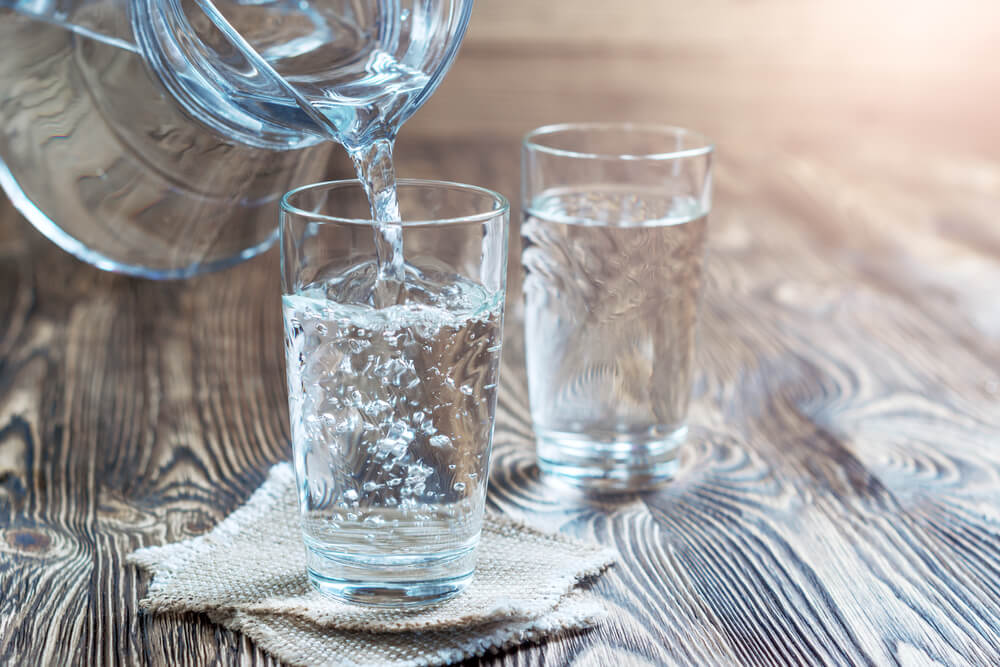In this article, we provide you a comprehensive comparison of purified vs distilled water. We define each type of drinking water, its benefits, and risks. We also dive into the difference between purified and distilled water. Lastly, we give you a recommendation on the best choice for drinking water and optimizing your health.
Distilled Water vs. Purified Water Differences
Even though distilled water is still a form of purified water, there is very little difference between distilled and purified water. It all depends on the specific process that the water endures during purification.
The only minor difference between purified and distilled water is that boiling water in distillation utilizes a high amount of energy to transform the liquid into steam. Purified water, on the other hand, gets processed via other means, such as sand filtration, reverse osmosis, and ion exchange.
What is Purified Water?
Purified water is a type of water that has been processed or filtered to eliminate chemicals, contaminants, and other impurities. You define purified water by the impurity levels (or lack thereof) found in the liquid. These contaminants must get removed to a low enough level to meet the definition of “purified water.” These removed impurities include elements like:
- Bacteria
- Fungi
- Algae
- Parasites
- Copper
- Lead
- Chemical pollutants
Purified water usually gets produced using tap water or groundwater. There are also many different methods to purify water in the home and commercially. These methods include
- Coagulation and flocculation – positive chemicals are mixed into the water, which binds to the negative particles to get filtered out (floc is produced here)
- Sedimentation – because of the larger size, floc falls near the bottom of the water, separated from the cleaner water
- Filtration – the remaining freshwater runs through many different filtration systems, composed of charcoal, sand, and gravel (removal of bacteria, dust, chemicals, and viruses happens here)
- Disinfection – chemical disinfectants are mixed in with the water to eliminate any remaining viruses or bacteria that may have survived the earlier steps
It is important to note that water purification standards differ significantly around the world. In many Western or developed countries, public drinking water is safe for consumption because it goes through a robust purification process. According to the World Health Organization, over 2.1 billion people are deprived of access to reliable, purified drinking water.

Purified Water Pros
Because of the Safe Water Drinking Act, the different states have differing water regulations and standards than others. There are measures and steps taken to make sure that public drinking water is safe for human consumption.
But there is a good chance that approved water still contains contaminants, which could be detrimental to our long-term health. Metals like copper and lead are incredibly toxic to our bodies and cause stomach diseases and brain damage. Purified water is the best solution to eliminating these trace contaminants from the water we drink.
Whether in-house water filters or bottled water, these purified water sources do an excellent job of removing contaminants and other chemicals. Charcoal filters are effective at eliminating chlorine, which is a common chemical mixed into public water to be used as a disinfectant.
Another advantage to purified water is that the purification process removes disgusting tastes that arise from chemical treatments, metal plumbing, or organic matter. You will notice a much superior, fresh taste. In addition to the improved taste, the smell will also be pleasant as you go in for that refreshing drink.
Lastly, purified water contains the essential minerals that strengthen our bodies. Purified water is full of Magnesium, Calcium, and Potassium. Be aware of focusing on reverse osmosis purification, which removes the essential minerals from the water.
Purified Water Cons
Although purified water provides numerous health benefits, there are some potential risks and drawbacks. The first con is that purified water removes the mineral fluoride, which is crucial in improving dental health and reducing dental decay.
If your household runs a purification system on its own, it takes time and money to maintain it consistently. Improperly maintained purification systems could produce harmful contaminants that will grow in the old filter and seep into your drinking water.
Another disadvantage of purified water is that it is not 100% effective. There is a small chance that the purification process will not eliminate some contaminants from the water. Depending on the kind of purification system utilized, certain chemicals and pollutants will find a way to remain in the water.
Establishing a purified water system is also a costly process. Whether you buy a purified bottle of water or install an in-home system could cost you hundreds of dollars. This investment does not guarantee that it will be 100% effective either. You must also factor in the ongoing cost of maintaining or repairing the water filtration system.
Lastly, purified water can lead to excess waste in the form of plastic bottles. You also create extra waste when you dispose of your used filters from your in-house purification systems.
What is Distilled Water?
Distilled water is produced through a distillation process that also aims to purify the water. When you distill water using the best water distiller, you boil out the contaminants using pure H2O. Most of the contaminants in water are inorganic minerals or metals. These particles have higher melting points and boiling points.
As the water gets boiled, the pure water transforms into steam. This steam is cooled and captured, which turns it into distilled water. The contaminants and other junk get left behind after this process is complete. Much like the purification process, the distillation process is effective at removing viruses, bacteria, protozoa, lead, and sulfate.
Because of the purity levels of distilled water, it usually gets used in laboratories and medical facilities. It is not as popular or common as purified water, but many people elect to drink distilled water because it is contaminate-free water.
But is distilled water 100% safe? Many volatile compounds exist in water, and most of this organic matter has boiling points lower than pure water. When the water is heated during the distillation process, the volatiles boil out first, and then the purified water. Therefore, you must have other purification technology in place to remove all contaminants.

Distilled Water Pros
It is no secret that the water distillation process is a formidable method to eliminate contaminants within the drinking water. The boiling process helps remove bacteria and pesticides that could harm people with compromised immune systems. People with HIV/AIDS and various cancers are in danger of getting sick from water impurities. These at-risk people benefit significantly from distilled drinking water.
Distilled water also does an excellent job of eliminating chlorine from drinking water. Not only does this improve the water taste, but it also protects from chlorine exposure. Drinking distilled water will help strengthen your immune system in the long run for this reason.
Distilled water also contains nearly no minerals, trace elements, or solids. It provides a useful resource for many situations, including:
- Drinking water
- Baby formula
- Baking and cooking
- Pet drinking water
- Water for seeds and plants
- Hair washing
- Car radiators and batteries
- Cleaning
- Other healthcare uses
Distilled Water Cons
Although distilled water is considered one of the purest types of water, it may not be the healthiest option. The distillation process effectively eliminates harmful chemicals and contaminants, but it also removes electrolytes and natural minerals in the drinking water.
While the steam rises in the distillation process, crucial minerals like magnesium and calcium get left behind. Distillation removes almost 100% of the minerals that reside in tap water.
Water is not the primary source of minerals, but any situation that includes a decreased ingestion of minerals is a risk to your health. If you abide by a well-balanced diet and drink distilled water, your health will not be negatively affected.
So, Which One Is Better?
So which option is better in the purified vs distilled water debate?
Distilled water and its distillation process are the most effective method for water treatment. Although it might not be as healthy as some purification process, it does a better job of removing contaminants. Distillation is also a unique process that boils water and kills viruses, bacteria, and other biological contaminants.
Distilled water also delivers much more consistent results, and you will not see a drop in quality as time goes on. Distilled water is recommended by nutritionists, doctors, and sports teams. It is considered one of the cleanest drinking waters on earth. It is useful for both non-consumable and consumable situations. Your health is the most significant priority, and it starts with contaminant-free, distilled water.
More from the Blog:






